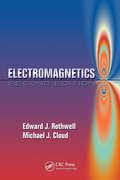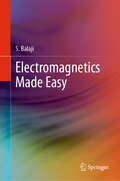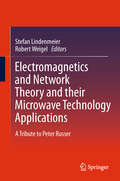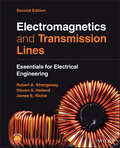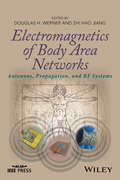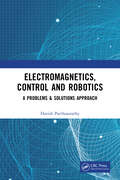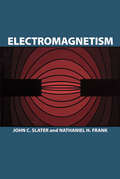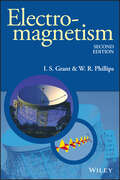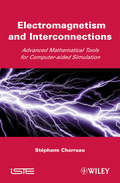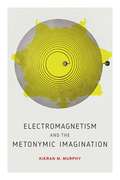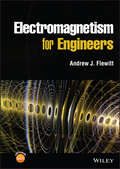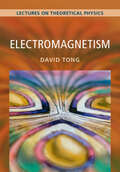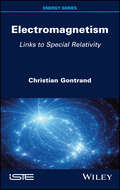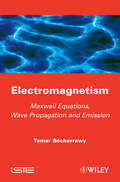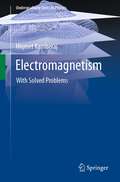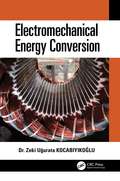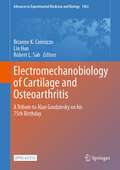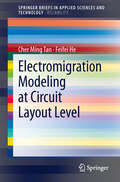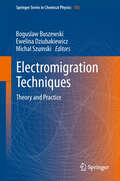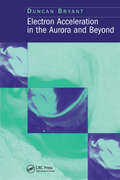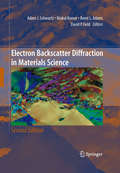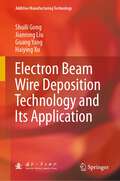- Table View
- List View
Electromagnetics (Electrical Engineering Textbook Ser.)
by Michael J. Cloud Edward J. Rothwell<p>Providing an ideal transition from introductory to advanced concepts, Electromagnetics, Second Edition builds a foundation that allows electrical engineers to confidently proceed with the development of advanced EM studies, research, and applications. <p>This second edition of a popular text continues to offer coverage that spans the entire field, from electrostatics to the integral solutions of Maxwell’s equations. The book provides a firm grounding in the fundamental concepts of electromagnetics and bolsters understanding through the use of classic examples in shielding, transmission lines, waveguides, propagation through various media, radiation, antennas, and scattering. Mathematical appendices present helpful background information in the areas of Fourier transforms, dyadics, and boundary value problems. The second edition adds a new and extensive chapter on integral equation methods with applications to guided waves, antennas, and scattering. <p>Utilizing the engaging style that made the first edition so appealing, this second edition continues to emphasize the most enduring and research-critical electromagnetic principles.</p>
Electromagnetics Made Easy
by S. BalajiThis book is intended to serve as an undergraduate textbook for a beginner’s course in engineering electromagnetics. The present book provides an easy and simplified understanding of the basic principles of electromagnetics. Abstract theory has been explained using real life examples making it easier for the reader to grasp the complicated concepts. An introductory chapter on vector calculus and the different coordinate systems equips the readers with the prerequisite knowledge to learn electromagnetics. The subsequent chapters can be grouped into four broad sections – electrostatics, magnetostatics, time varying fields, and applications of electromagnetics. Written in lucid terms, the text follows a sequential presentation of the topics, and discusses the relative merits and demerits of each method. Each chapter includes a number of examples which are solved rigorously along with pictorial representations. The book also contains about 400 figures and illustrations which help students visualize the underlying physical concepts. Several end-of-chapter problems are provided to test the key concepts and their applications. Thus the book offers a valuable resource for both students and instructors of electrical, electronics and communications engineering, and can also be useful as a supplementary text for undergraduate physics students.
Electromagnetics and Network Theory and their Microwave Technology Applications
by Robert Weigel Stefan LindenmeierThis volume provides a discussion of the challenges and perspectives of electromagnetics and network theory and their microwave applications in all aspects. It collects the most interesting contribution of the symposium dedicated to Professor Peter Russer held in October 2009 in Munich.
Electromagnetics and Transmission Lines: Essentials for Electrical Engineering
by Steven Sean Holland Robert Alan Strangeway James Elwood RichieElectromagnetics and Transmission Lines Textbook resource covering static electric and magnetic fields, dynamic electromagnetic fields, transmission lines, antennas, and signal integrity within a single course Electromagnetics and Transmission Lines provides coverage of what every electrical engineer (not just the electromagnetic specialist) should know about electromagnetic fields and transmission lines. This work examines several fundamental electrical engineering concepts and components from an electromagnetic fields viewpoint, such as electric circuit laws, resistance, capacitance, and self and mutual inductances. The approach to transmission lines (T-lines), Smith charts, and scattering parameters establishes the underlying concepts of vector network analyzer (VNA) measurements. System-level antenna parameters, basic wireless links, and signal integrity are examined in the final chapters. As an efficient learning resource, electromagnetics and transmission lines content is strategically modulated in breadth and depth towards a single semester objective. Extraneous, distracting topics are excluded. The wording style is somewhat more conversational than most electromagnetics textbooks in order to enhance student engagement and inclusivity while conveying the rigor that is essential for engineering student development. To aid in information retention, the authors also provide supplementary material, including a homework solutions manual, lecture notes, and VNA experiments. Sample topics covered in Electromagnetics and Transmission Lines include: Vector algebra and coordinate systems, Coulomb’s law, Biot-Savart law, Gauss’s law, and solenoidal magnetic flux Electric potential, Ampere’s circuital law, Faraday’s law, displacement current, and the electromagnetic principles underlying resistance, capacitance, and self and mutual inductances The integral form of Maxwell’s equations from a conceptual viewpoint that relates the equations to physical understanding (the differential forms are also included in an appendix) DC transients and AC steady-state waves, reflections, and standing waves on T-lines Interrelationships of AC steady-state T-line theory, the Smith chart, and scattering parameters Antenna basics and line-of-sight link analysis using the Friis equation An introduction to signal integrity Electromagnetics and Transmission Lines is an authoritative textbook learning resource, suited perfectly for engineering programs at colleges and universities with a single required electromagnetic fields course. Student background assumptions are multivariable calculus, DC and AC electric circuits, physics of electromagnetics, and elementary differential equations.
Electromagnetics of Body Area Networks: Antennas, Propagation, and RF Systems
by Zhi Hao Jiang Douglas H. WernerThe book is a comprehensive treatment of the field, covering fundamental theoretical principles and new technological advancements, state-of-the-art device design, and reviewing examples encompassing a wide range of related sub-areas. In particular, the first area focuses on the recent development of novel wearable and implantable antenna concepts and designs including metamaterial-based wearable antennas, microwave circuit integrated wearable filtering antennas, and textile and/or fabric material enabled wearable antennas. The second set of topics covers advanced wireless propagation and the associated statistical models for on-body, in-body, and off-body modes. Other sub-areas such as efficient numerical human body modeling techniques, artificial phantom synthesis and fabrication, as well as low-power RF integrated circuits and related sensor technology are also discussed. These topics have been carefully selected for their transformational impact on the next generation of body-area network systems and beyond.
Electromagnetics, Control and Robotics: A Problems & Solutions Approach
by Harish ParthasarathyThis book covers a variety of problems, and offers solutions to some, in:• Statistical state and parameter estimation in nonlinear stochastic dynamical system in both the classical and quantum scenarios.• Propagation of electromagnetic waves in a plasma as described by the Boltzmann Kinetic Transport Equation.• Classical and Quantum General Relativity. It will be of use to Engineering undergraduate students interested in analysing the motion of robots subject to random perturbation, and also to research scientists working in Quantum Filtering.
Electromagnetism
by John C. Slater Nathaniel H. FrankClearly developed from first principles, this introductory study supplies basic material on electrostatics and magnetostatics, then concentrates on electromagnetic theory -- the authors are both leading men in the field. The book ranges freely over many areas of electromagnetic theory with some concern for electrical engineering. It covers the field theory of electromagnetism, electrostatics and the equations and theorems of Gauss, Poisson, Laplace and Green, solutions of Laplace's equation, dielectrics, magnetic fields of linear and circular currents, electromagnetic induction and Maxwell's equations, electromagnetic waves, electron theory, wave guides and cavity resonators, spherical electromagnetic waves, Huygen's principle and Green's theorem, and Fresnel and Fraunhofer diffraction. Practice problems are supplied at chapter ends.Physicists and engineers will find this presentation particularly useful; but mathematicians have also used the book not only as an introduction to electromagnetism, but also as a means to an increased knowledge of the aims and tools of theoretical physics. The only background required to follow the development is a knowledge of the calculus and differential equations. More advanced mathematics is developed in appendixes.
Electromagnetism (Manchester Physics Series #Vol. 18)
by I. S. Grant W. R. PhillipsThe Manchester Physics Series General Editors: D. J. Sandiford; F.Mandl; A. C. Phillips Department of Physics and Astronomy,University of Manchester Properties of Matter B. H. Flowers and E.Mendoza Optics Second Edition F. G. Smith and J. H. ThomsonStatistical Physics Second Edition F. Mandl Electromagnetism SecondEdition I. S. Grant and W. R. Phillips Statistics R. J. BarlowSolid State Physics Second Edition J. R. Hook and H. E. HallQuantum Mechanics F. Mandl Particle Physics Second Edition B. R.Martin and G. Shaw the Physics of Stars Second Edition A. C.Phillips Computing for Scientists R. J. Barlow and A. R. BarnettElectromagnetism, Second Edition is suitable for a first course inelectromagnetism, whilst also covering many topics frequentlyencountered in later courses. The material has been carefullyarranged and allows for flexi-bility in its use for courses ofdifferent length and structure. A knowledge of calculus and anelementary knowledge of vectors is assumed, but the mathematicalproperties of the differential vector operators are described insufficient detail for an introductory course, and their physicalsignificance in the context of electromagnetism is emphasised. Inthis Second Edition the authors give a fuller treatment of circuitanalysis and include a discussion of the dispersion ofelectromagnetic waves. Electromagnetism, Second Edition features: * The application of the laws of electromagnetism to practicalproblems such as the behaviour of antennas, transmission lines andtransformers. * Sets of problems at the end of each chapter to help studentunderstanding, with hints and solutions to the problems given atthe end of the book. * Optional "starred" sections containing more specialised andadvanced material for the more ambitious reader. * An Appendix with a thorough discussion of electromagneticstandards and units. Recommended by many institutions. Electromagnetism. SecondEdition has also been adopted by the Open University as the coursebook for its third level course on electromagnetism.
Electromagnetism and Interconnections: Advanced Mathematical Tools for Computer-aided Simulation
by Stephane CharruauThis book covers the theoretical problems of modeling electrical behavior of the interconnections encountered in everyday electronic products. The coverage shows the theoretical tools of waveform prediction at work in the design of a complex and high-speed digital electronic system. Scientists, research engineers, and postgraduate students interested in electromagnetism, microwave theory, electrical engineering, or the development of simulation tools software for high speed electronic system design automation will find this book an illuminating resource.
Electromagnetism and the Metonymic Imagination (AnthropoScene #4)
by Kieran M. MurphyHow does the imagination work? How can it lead to both reverie and scientific insight? In this book, Kieran M. Murphy sheds new light on these perennial questions by showing how they have been closely tied to the history of electromagnetism.The discovery in 1820 of a mysterious relationship between electricity and magnetism led not only to technological inventions—such as the dynamo and telegraph, which ushered in the “electric age”—but also to a profound reconceptualization of nature and the role the imagination plays in it. From the literary experiments of Edgar Allan Poe, Honoré de Balzac, Villiers de l’Isle-Adam, and André Breton to the creative leaps of Michael Faraday and Albert Einstein, Murphy illuminates how electromagnetism legitimized imaginative modes of reasoning based on a more acute sense of interconnection and a renewed interest in how metonymic relations could reveal the order of things.Murphy organizes his study around real and imagined electromagnetic devices, ranging from Faraday’s world-changing induction experiment to new types of chains and automata, in order to demonstrate how they provided a material foundation for rethinking the nature of difference and relation in physical and metaphysical explorations of the world, human relationships, language, and binaries such as life and death. This overlooked exchange between science and literature brings a fresh perspective to the critical debates that shaped the nineteenth century.Extensively researched and convincingly argued, this pathbreaking book addresses a significant lacuna in modern literary criticism and deepens our understanding of both the history of literature and the history of scientific thinking.
Electromagnetism and the Metonymic Imagination (AnthropoScene: The SLSA Book Series #4)
by Kieran M. MurphyHow does the imagination work? How can it lead to both reverie and scientific insight? In this book, Kieran M. Murphy sheds new light on these perennial questions by showing how they have been closely tied to the history of electromagnetism.The discovery in 1820 of a mysterious relationship between electricity and magnetism led not only to technological inventions—such as the dynamo and telegraph, which ushered in the "electric age"—but also to a profound reconceptualization of nature and the role the imagination plays in it. From the literary experiments of Edgar Allan Poe, Honoré de Balzac, Villiers de l’Isle-Adam, and André Breton to the creative leaps of Michael Faraday and Albert Einstein, Murphy illuminates how electromagnetism legitimized imaginative modes of reasoning based on a more acute sense of interconnection and a renewed interest in how metonymic relations could reveal the order of things.Murphy organizes his study around real and imagined electromagnetic devices, ranging from Faraday’s world-changing induction experiment to new types of chains and automata, in order to demonstrate how they provided a material foundation for rethinking the nature of difference and relation in physical and metaphysical explorations of the world, human relationships, language, and binaries such as life and death. This overlooked exchange between science and literature brings a fresh perspective to the critical debates that shaped the nineteenth century.Extensively researched and convincingly argued, this pathbreaking book addresses a significant lacuna in modern literary criticism and deepens our understanding of both the history of literature and the history of scientific thinking.
Electromagnetism for Engineers
by Andrew J. FlewittElectromagnetism for Engineers An easily accessible textbook to introduce the power of electromagnetism Electromagnetism can be a difficult subject to grasp and to teach. Much of what we take for granted in modern life is enabled by electromagnetic effects, but it isn’t always easy to understand the impact of electromagnetism compared to other areas of engineering, such as mechanics, which are more tangibly observed and felt. Although electromagnetism is a crucial and important branch of physics with elegant mathematics, many students can find the study of electromagnetism inaccessible. It is crucial for students of electrical and electronic engineering and physics to have a strong understanding of electromagnetism and how it impacts communications, power generation and transmission, semiconductor devices, motors, and more. Electromagnetism for Engineers aims to develop a student’s understanding of electromagnetism in the context of real effects and how they apply to such applications, whilst maintaining the sophistication of the mathematics that can be used to give deeper insight. It begins by describing the fundamentals of electromagnetism before a more detailed discussion of the basic concepts developed for specific application areas. It then considers the application of electromagnetism to transmission lines, antennas, and waveguides. Electromagnetism for Engineers readers will find: A unique approach that illustrates the link between real-life applications and fundamental theory of electromagnetism Clear, concise language to help students gain a full understanding of the subject Carefully designed figures to illustrate points throughout the book Accompanying website at www.wiley.com/go/flewitt1418 Electromagnetism for Engineers has been written as a textbook for undergraduates studying electronic or electrical engineering. The manual can also be of interest to physics students and??to graduate-level students desirous of having a general book on electromagnetism. It is also a useful reference for professional engineers looking for a refresher on the fundamentals of electromagnetism.
Electromagnetism: Lectures on Theoretical Physics
by David TongThere are four forces in our universe. Two act only at the very smallest scales and one only at the very biggest. For everything inbetween, there is electromagnetism. The theory of electromagnetism is described by four gloriously simple and beautiful vector calculus equations known as the Maxwell equations. These are the first genuinely fundamental equations that we meet in our physics education and they survive, essentially unchanged, in our best modern theories of physics. They also serve as a blueprint for what subsequent laws of physics look like. This textbook takes us on a tour of the Maxwell equations and their many solutions. It starts with the basics of electric and magnetic phenomena and explains how their unification results in waves that we call light. It then describes more advanced topics such as superconductors, monopoles, radiation, and electromagnetism in matter. The book concludes with a detailed review of the mathematics of vector calculus.
Electromagnetism: Links to Special Relativity
by Christian GontrandElectromagnetism: Links to Special Relativity
Electromagnetism: Maxwell Equations, Wave Propagation and Emission (Wiley-iste Ser.)
by Tamer BecherrawyThis book deals with electromagnetic theory and its applications at the level of a senior-level undergraduate course for science and engineering. The basic concepts and mathematical analysis are clearly developed and the important applications are analyzed. Each chapter contains numerous problems ranging in difficulty from simple applications to challenging. The answers for the problems are given at the end of the book. Some chapters which open doors to more advanced topics, such as wave theory, special relativity, emission of radiation by charges and antennas, are included. The material of this book allows flexibility in the choice of the topics covered. Knowledge of basic calculus (vectors, differential equations and integration) and general physics is assumed. The required mathematical techniques are gradually introduced. After a detailed revision of time-independent phenomena in electrostatics and magnetism in vacuum, the electric and magnetic properties of matter are discussed. Induction, Maxwell equations and electromagnetic waves, their reflection, refraction, interference and diffraction are also studied in some detail. Four additional topics are introduced: guided waves, relativistic electrodynamics, particles in an electromagnetic field and emission of radiation. A useful appendix on mathematics, units and physical constants is included. Contents 1. Prologue. 2. Electrostatics in Vacuum. 3. Conductors and Currents. 4. Dielectrics. 5. Special Techniques and Approximation Methods. 6. Magnetic Field in Vacuum. 7. Magnetism in Matter. 8. Induction. 9. Maxwell’s Equations. 10. Electromagnetic Waves. 11. Reflection, Interference, Diffraction and Diffusion. 12. Guided Waves. 13. Special Relativity and Electrodynamics. 14. Motion of Charged Particles in an Electromagnetic Field. 15. Emission of Radiation.
Electromagnetism: With Solved Problems (Undergraduate Texts in Physics)
by Hiqmet KamberajAny curriculum involving science and/or engineering will eventually find itself entering the realm of physics. This book seeks to introduce students to a number of the fundamental concepts in physics and illustrate how different theories were developed out of physical observations and phenomena. The book presents multi-chapter sections on electrostatics, magnetism and electromagnetic waves, with eyes on both the past and the future, touching, along the way, on Coulomb, Gauss, Maxwell, Ohm, Biot-Savart, Ampere, Faraday, Fresnel and Lorentz. The book also contains an appendix that provides the reader with a portion of the mathematical background of vector analysis and vector differential operators. The book approaches its topics through a focus on examples and problem-solving techniques, illustrating vividly how physical theories are applied to problems in engineering and science. The book is primarily aimed at undergraduate students in these two fields, but it also features chapters that are geared towards senior undergraduates working on their final year theses.
Electromechanical Control Technology and Transportation: Proceedings of the 2nd International Conference on Electromechanical Control Technology and Transportation (ICECTT 2017), January 14-15, 2017, Zhuhai, China
by Feng Wu Xiaoling JiaThe 2017 2nd International Conference on Electromechanical Control Technology and Transportation (ICECTT 2017) was held on January 14–15, 2017 in Zhuhai, China. ICECTT 2017 brought together academics and industrial experts in the field of electromechanical control technology and transportation to a common forum. The primary goal of the conference was to promote research and developmental activities in electromechanical control technology and transportation. Another goal was to promote exchange of scientific information between researchers, developers, engineers, students, and practitioners working all around the world. The conference will be held every year thus making it an ideal platform for people to share views and experiences in electromechanical control technology and transportation and related areas.
Electromechanical Energy Conversion
by Zeki Uğurata KocabiyikoğluThis book is intended to be a textbook for undergraduate students studying electrical and electronic engineering in universities and colleges. Therefore, the level and amount of the knowledge to be transferred to the reader is kept to as much as what can be taught in one academic semester of a university or a college course. Although the subject is rather classical and somehow well established in some respects, it is vast and can be difficult to grasp if unnecessary details are not avoided. This book is aimed to give the reader just what is necessary - with plenty of short and easily understandable examples and drawings, figures, and tables. A course on electromechanical energy conversion is a necessity in all universities and colleges entitled to grant a license for electrical engineering. This book is aimed at meeting the requirements of this essential subject by providing necessary information to complete the course. A compact chapter is included with figures and tables on energy and the restraints on its production brought about by global climate change. A new approach has been tried for some of the classic subjects including magnetic circuits and electrical machines together with today’s much-used motors.
Electromechanical Systems and Devices
by Sergey Edward LyshevskiStudents entering today's engineering fields will find an increased emphasis on practical analysis, design, and control. They must be able to translate their advanced programming abilities and sound theoretical backgrounds into superior problem-solving skills. Electromechanical Systems and Devices facilitates the creation of critical problem-solvin
Electromechanobiology of Cartilage and Osteoarthritis: A Tribute to Alan Grodzinsky on his 75th Birthday (Advances in Experimental Medicine and Biology #1402)
by Brianne K. Connizzo Lin Han Robert L. SahThis is an open access book. In honor of his 75th birthday, we reflect on the impact of the pioneering work of Alan Grodzinsky and his laboratory. This volume includes in-depth discussions of tissue electromechanics, mechanobiology and biomechanics, and matrix biology in addition to the latest advancements in understanding the pathogenesis, progression and treatment of osteoarthritis. Unique to this volume, we overview decades of groundbreaking research that set the stage for the latest efforts in the field, highlighting the legacy of one researcher and their trainees.
Electromigration Modeling at Circuit Layout Level
by Cher Ming Tan Feifei HeIntegrated circuit (IC) reliability is of increasing concern in present-day IC technology where the interconnect failures significantly increases the failure rate for ICs with decreasing interconnect dimension and increasing number of interconnect levels. Electromigration (EM) of interconnects has now become the dominant failure mechanism that determines the circuit reliability. This brief addresses the readers to the necessity of 3D real circuit modelling in order to evaluate the EM of interconnect system in ICs, and how they can create such models for their own applications. A 3-dimensional (3D) electro-thermo-structural model as opposed to the conventional current density based 2-dimensional (2D) models is presented at circuit-layout level.
Electromigration Techniques
by Michal Szumski Ewelina Dziubakiewicz Boguslaw BuszewskiThe book provides the broad knowledge on electromigration techniques including: theory of CE, description of instrumentation, theory and practice in micellar electrokinetic chromatography, isotachophoresis, capillary isoelectric focusing, capillary and planar electrochromatography (including description of instrumentation and packed and monolithic column preparation), 2D-gel electrophoresis (including sample preparation) and lab-on-a-chip systems. The book also provides the most recent examples of applications including food, environmental, pharmaceutical analysis as well as proteomics.
Electron Acceleration in the Aurora and Beyond
by D BryantHow did electrons in the high atmosphere and space around the Earth come to acquire their speeds and energies?This intriguing question lies at the heart of understanding how high-energy electrons create the spectacular displays of the ^IAurora Borealis and ^IAurora Australis. Electron Acceleration in the Aurora and Beyond explores the mysteries
Electron Backscatter Diffraction in Materials Science
by Brent L. Adams Mukul Kumar Adam J. Schwartz David P. FieldElectron backscatter diffraction is a very powerful and relatively new materials characterization technique aimed at the determination of crystallographic texture, grain boundary character distributions, lattice strain, phase identification, and much more. The purpose of this book is to provide the fundamental basis for electron backscatter diffraction in materials science, the current state of both hardware and software, and illustrative examples of the applications of electron backscatter diffraction to a wide-range of materials including undeformed and deformed metals and alloys, ceramics, and superconductors. The text has been substantially revised from the first edition, and the authors have kept the format as close as possible to the first edition text. The new developments covered in this book include a more comphrensive coverage of the fundamentals not covered in the first edition or other books in the field, the advances in hardware and software since the first edition was published, and current examples of application of electron backscatter diffraction to solve challenging problems in materials science and condensed-matter physics.
Electron Beam Wire Deposition Technology and Its Application (Additive Manufacturing Technology)
by Guang Yang Shuili Gong Jianrong Liu Haiying XuThis book provides a systematic and comprehensive introduction to the technical principles, materials, processes, and equipment of the electron beam wire deposition technology (EBWD), while focusing on the research results of the author’s scientific research team engaged in this technology in China. It mainly introduces the conceptual connotation, principle, and characteristics of the EBWD technology, its position and function in the additive manufacturing technology system, the direction and trend of technological development at home and abroad, the fundamentals and application results of the EBWD technology, including technical principles, equipment technology, special materials, manufacturing technology, quality testing, and application practices. So this book can serve as a reference book for teachers, students, and scientific researchers in scientific research institutions who are engaged in relevant studies.
